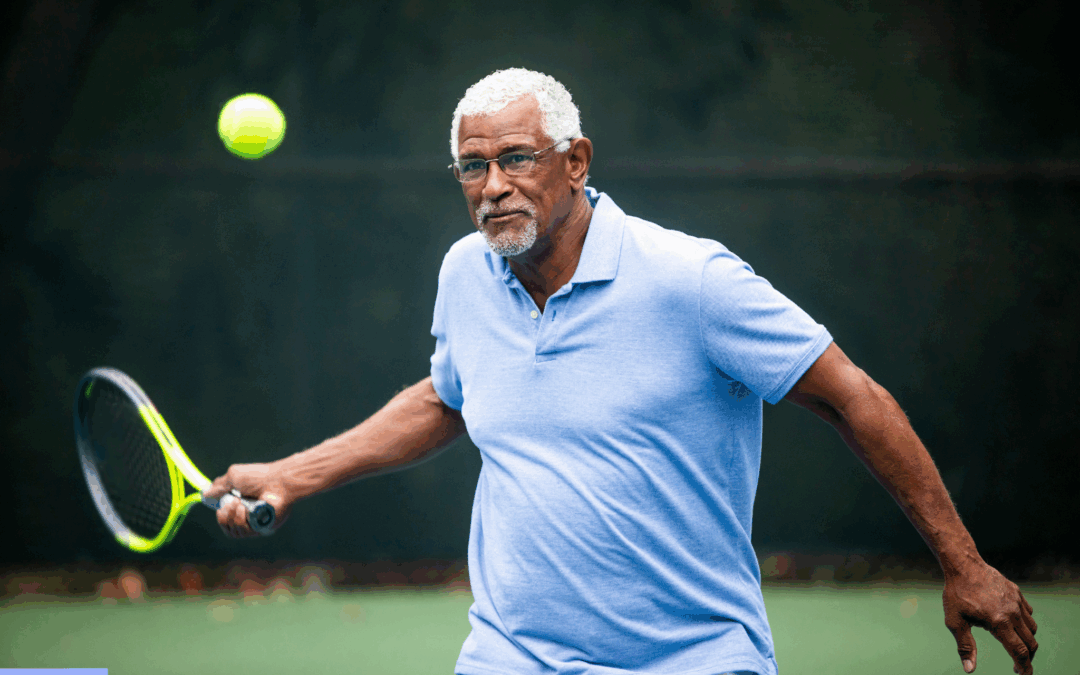Key Takeaways:
- Tennis injuries frequently result from repetitive stress and improper technique.
- Early intervention using physical therapy and shockwave therapy significantly speeds recovery.
- Integrative care combining advanced treatments helps tennis players return safely to play.
Tennis is an exhilarating sport known for its dynamic, high-impact movements, quick pivots, explosive serves, powerful forehands, and agile footwork. But this intensity, although beneficial for cardiovascular fitness and muscle development, also places considerable strain on your joints, tendons, and muscles. As a result, tennis players, both recreational and professional, frequently encounter injuries.
Understanding common tennis injuries, their symptoms, effective treatment options, and prevention strategies is crucial for anyone looking to stay healthy, perform better, and enjoy the game safely for years to come.
Tennis Elbow (Lateral Epicondylitis)
Arguably the most notorious injury associated with tennis, lateral epicondylitis, commonly known as “tennis elbow,” affects the tendons on the outer side of the elbow. Despite its name, tennis elbow isn’t exclusive to tennis players, any repetitive wrist and arm motions can trigger it. However, tennis players are particularly susceptible due to repeated backhand swings, especially with improper technique or inadequate equipment.
Symptoms and Causes:
Tennis elbow typically manifests as pain on the outside of the elbow, sometimes radiating down the forearm. Gripping objects, lifting, or even shaking hands can become painful. The root cause is repeated stress on the wrist extensor tendons, causing microtears and inflammation.
Effective Treatment Options:
Initial treatment includes rest, ice application, and over-the-counter anti-inflammatory medication. However, chronic cases may require additional interventions:
- Physical Therapy: Specific eccentric wrist-extension exercises to rebuild tendon strength.
- Shockwave Therapy (EPAT): Acoustic waves stimulate healing and regenerate damaged tendon fibers.
- PRP Injections: Platelet-rich plasma promotes tissue regeneration in persistent cases.
- Surgical Intervention: Reserved for severe, long-term cases unresponsive to conservative treatments.
Preventive Measures:
Prevention involves proper equipment (appropriate racquet grip size and tension), correct technique, and regular forearm strengthening exercises. Consider periodic coaching sessions to maintain good form.
Rotator Cuff Injuries
Your shoulder undergoes tremendous stress during serving and overhead shots, often resulting in rotator cuff injuries. The rotator cuff comprises muscles and tendons stabilizing the shoulder joint. Injuries can range from mild inflammation (tendinopathy) to partial or full-thickness tears.
Symptoms and Causes:
Common symptoms include shoulder weakness, limited overhead movement, and dull aches, especially at night. Repeated overhead motions or improper serving technique often contribute to these injuries.
Effective Treatment Options:
Early-stage rotator cuff injuries benefit from conservative care:
- Physical Therapy: Strengthening and stretching exercises targeting shoulder muscles.
- Shockwave Therapy: Promotes tendon healing and reduces inflammation.
- Corticosteroid Injections: For immediate pain relief and inflammation reduction in acute flare-ups.
Severe tears might necessitate surgical repair, followed by extensive rehabilitation.
Preventive Measures:
Maintain shoulder strength through targeted exercises. Adjust your serve mechanics, avoiding overly forceful or unnatural movements. Incorporate shoulder-specific warm-ups before play.
Knee Injuries (Patellar Tendinopathy and Meniscus Tears)
Explosive directional changes and constant pivoting place significant stress on your knees, commonly leading to patellar tendinopathy (jumper’s knee) or meniscal injuries.
Symptoms and Causes:
Patellar tendinopathy causes pain just below the kneecap, worsening with jumping or abrupt movements. Meniscal injuries produce swelling, stiffness, and sometimes locking sensations during knee movement. Overuse, improper technique, and sudden twists or impacts often trigger these injuries.
Effective Treatment Options:
Patellar tendinopathy responds well to:
- Load Management: Temporary reduction in training intensity.
- Physical Therapy: Eccentric strengthening exercises and stretching.
- Shockwave Therapy: Enhances tendon regeneration and healing processes.
- Meniscal injuries, depending on severity, may require:
- Physical Therapy: To regain strength and stability around the joint.
- Arthroscopic Surgery: Minimally invasive procedure for severe tears.
Preventive Measures:
Maintain lower limb strength, particularly quadriceps, hamstrings, and calf muscles. Proper footwear with adequate cushioning and lateral support is essential. Include plyometric drills gradually to condition tendons and ligaments for tennis demands.
Wrist Strains and Sprains
Rapid wrist movements and repetitive volleys put players at risk for wrist injuries, including ligament sprains and tendon strains.
Symptoms and Causes:
Pain, swelling, and reduced wrist flexibility indicate wrist injuries. Incorrect grip technique, excessive topspin, or sudden awkward swings often cause wrist sprains or tendon irritation.
Effective Treatment Options:
- Physical Therapy: Wrist-strengthening and mobility exercises.
- Bracing or Taping: Supports the wrist during recovery.
- Shockwave Therapy: Accelerates tendon recovery for chronic wrist injuries.
Preventive Measures:
Focus on grip technique to ensure wrist neutrality during swings. Strengthen forearm muscles regularly. Use wrist braces temporarily if returning from injury.
Ankle Sprains
Lateral ankle sprains frequently occur when players suddenly pivot or land awkwardly during play, overstretching or tearing ligaments.
Symptoms and Causes:
Immediate swelling, bruising, and difficulty bearing weight are classic signs of an ankle sprain. Quick direction changes, improper footwork, or slippery surfaces are typical causes.
Effective Treatment Options:
- Immediate Ice and Elevation: Reduce swelling immediately.
- Compression Bandages and Ankle Bracing: Provide stability and aid healing.
- Physical Therapy: Balance training, proprioception exercises, and ankle strengthening.
- Shockwave Therapy: Enhances ligament recovery and reduces pain in chronic cases.
Preventive Measures:
Improve ankle strength and flexibility through targeted exercises. Consider footwear designed specifically for tennis court surfaces, and perform agility drills regularly.
Lower Back Injuries
Repetitive twisting and bending motions required for tennis strokes can strain lower back muscles or compress spinal structures.
Symptoms and Causes:
Dull or sharp back pain, stiffness, and limited spinal mobility often indicate lower back injuries. Poor stroke mechanics, inadequate conditioning, and lack of flexibility contribute to spinal stress.
Effective Treatment Options:
- Rest and Gentle Mobilization: Avoid prolonged inactivity, encourage controlled movement.
- Physical Therapy: Core strengthening, flexibility routines, and posture correction.
- Chiropractic Care and Massage Therapy: Spinal adjustments and soft-tissue treatments.
- Shockwave Therapy: Useful in cases of chronic muscle or tendon involvement in the lumbar region.
Preventive Measures:
Prioritize core strength, spinal flexibility, and correct stroke mechanics. Regular stretching and controlled weight training support a resilient back.
Groin and Hip Injuries
Quick lateral movements can overstretch groin muscles or inflame hip tendons, causing discomfort that sidelines players.
Symptoms and Causes:
Sharp pain in the inner thigh or hip area, limited mobility, and difficulty moving laterally characterize groin and hip injuries. Poor flexibility and abrupt lateral movements are primary risk factors.
Effective Treatment Options:
- Rest and Progressive Return: Gradual reintroduction to lateral movements.
- Physical Therapy: Strengthen hip abductors/adductors, promote flexibility.
- Shockwave Therapy: Assists recovery in persistent tendon issues around the hip.
Preventive Measures:
Incorporate lateral agility and flexibility drills regularly. Hip-specific strength training provides protection against recurrent injuries.
Maximizing Treatment Outcomes
Successful treatment of tennis injuries goes beyond symptom relief. Integrative approaches, pairing modalities like shockwave therapy with personalized rehabilitation, provide optimal recovery and long-term resilience. Nutritional support, adequate hydration, sufficient sleep, and proper equipment selection are integral components of injury prevention and recovery.
Staying on Court with Confidence
Understanding common tennis injuries and available treatments equips you to recognize early signs, manage injuries proactively, and return safely to the sport you love. If persistent injuries affect your performance or quality of life, seeking specialized care can make a significant difference.
At Avid Sports Medicine, our dedicated team offers expert assessment, innovative treatments like shockwave therapy, and tailored rehabilitation programs specifically designed for tennis athletes. Whether you’re a competitive player or an enthusiastic weekend warrior, we aim to help you recover effectively and return confidently to your best game.
Schedule your consultation with Avid Sports Medicine today and take your first step toward injury-free tennis performance and lasting wellness.

